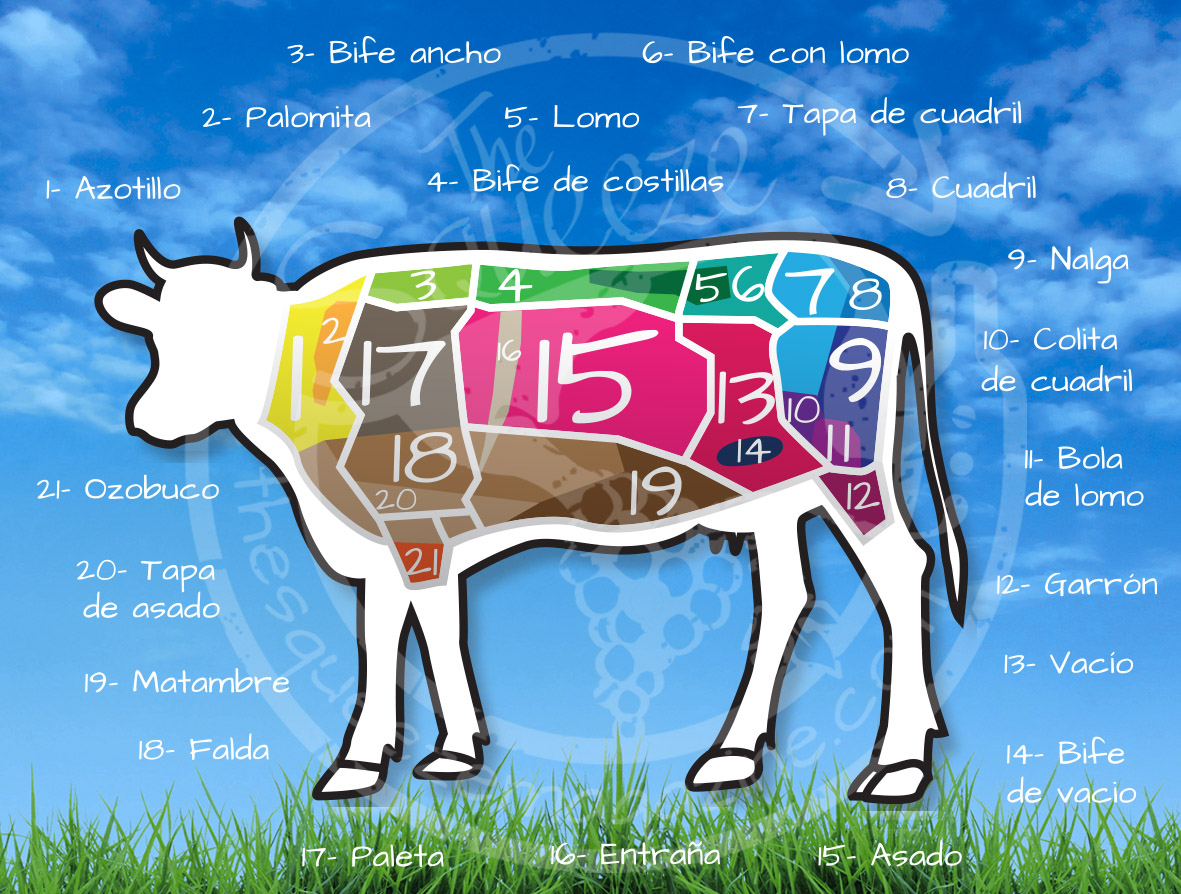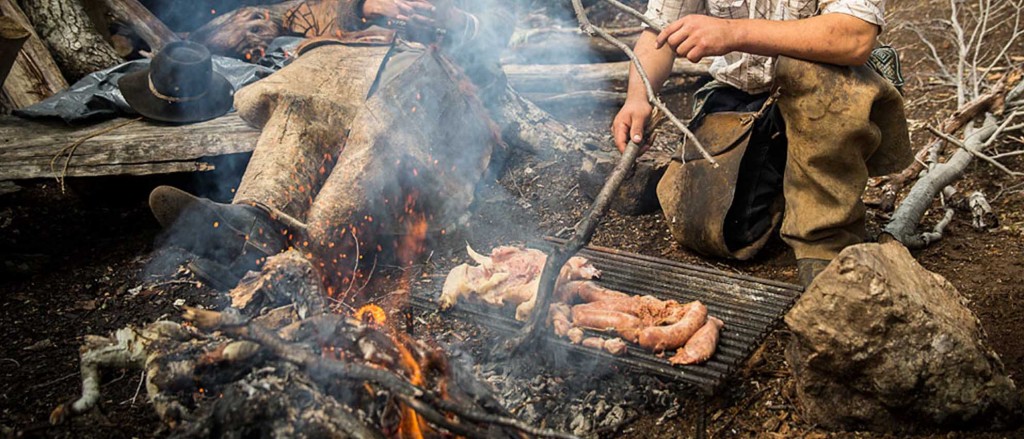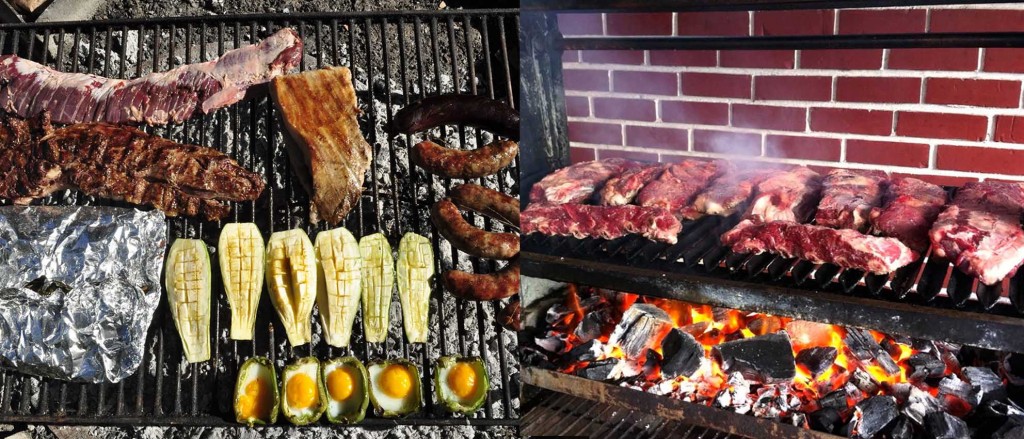Now the star of the show is obviously the meat! This is what makes grown men salivate like a 2-year-old at Halloween! Although the choice of cuts and kinds of meat is up to you, most asados have chorizo (pork sausage), morcilla (blood sausage), beef and pork. Sure a chicken might get thrown in there, but for the most part beef and pork reign supreme.
Continued from Part 1 Asado Series
Meat cuts for Argentine asado
What cut of meat to use? Well, good question, but keep in mind that in Argentina, the cow is butchered in a very different way. Many of the cuts we use are what you would consider the cap or cover of a cut like a shoulder or blade. Below is a short list of some of the more common cuts of meat we use for the Argentine asado, but before we dig into that – there are a couple key differences in making an Argentine asado compared to international barbeques.
- Butchering: A good example of the difference in butchering is in ribs. Where most people are accustomed to your butcher cutting the ribs between the actual rib themselves, in Argentina, the butcher cuts across the bones, very similar to the cut of short ribs.
- Salting the meat: In the same way that every asador has his own way of building the fire, every asador has his own way of salting the meat. In general, a coarse salt – whose equivalent would be Kosher Salt in the US – is used and only put onto the meat for a maximum of an hour before cooking. See more salting tips below!
Argentine Beef Cuts for Asados – in translation:
Vacío – Flank
This is a delicious cut of meat. Vacío is a thin cut which features a thin layer of fat on both sides. A good quality vacío is tender, flavorful and very juicy, contains no fat (other than the layer surrounding it). Argentines love this cut, it is a ‘must have’ at an asado, especially because of how the outside gets nice and crispy when cooked slowly over the embers.
Entraña – Skirt
This cut is very much like vacío although entraña is even thinner and features good marbling. It has a thin layer of white skin (silver skin) that most people outside of Argentina remove. For our asados, we leave it on because when cooked, it gets very crispy.
Asado de Costillar – Beef Rib
A must for a proper asado! Ribs have a small layer of fat in between the meat that adds just the right amount of flavour. Cooked low and slow, the ribs are often the last meat served.
Tapa de Asado – Rib Cap
This can be a tough cut, but Argentines do not mind a bit of chew with their meat. The tapa de asado is full of flavour. Usually well marbled, with some gristle. Cooked properly, it is a really flavourful cut.
Asado/Asado de Tira – Short/Cross Cut Rib
Always cooked low and slow, in order to render out the fat and let the meat get tenderized with the smoke of the asado and the marbling of the fat.
What to cook on your asado beyond beef
Although beef is the star of the show, an asado consists of many other supporting acts. Here are a few:
Chorizo – pork sausage
Chorizo varies in percentage of pork to beef filling. An 80/20 chorizo would be 80% pork and 20% beef and is the most common.
Morcilla- Blood Sausage
Like chorizo, morcilla is a must for all asados. Very closely related to black pudding in the UK, morcilla is pig’s blood, pieces of pork, seasoning and some kind of binder like rice or breadcrumbs.
Mollejas – Sweetbreads or Thymus Gland
Cooked right, they melt in your mouth! Some asadors will soak their mollejas overnight in milk. Although others say this takes away from the flavour it may have. I simply marinade my mollejas salt and lemon juice for at least an hour before cooking. A good asador will keep the mollejas cooking for a good two hours on a low temperature to get the sweetness to develop. Serve them piping hot on a piece of bread.
Chinchulín – Initial portion of small intestines
Not for everyone, but if you have a trusted butcher, chinchulín can be very flavourful. Like mollejas, some soak them in milk overnight or just cook them really slow with lots of lemon. Also served piping hot for the best flavour.
Cerdo – Pork
At least one cut of pork is usually served. The most common cuts are ribs and matambre – a long thin cut that lies just under the skin and runs from the lower part of the ribs to belly–or flank area. Matambre is particularly good cooked ‘low and slow’ so you get the fat layer nice and crispy.
Grilled veggies
As asado is rarely vegetarian-friendly, but grilled vegetables are often included in the asado. Peppers, onions, zucchini and eggplants are the most common vegetables that are grilled. A bit of olive oil and salt is all you need to bring out the sweetness of the fresh veggies.
Salt is where the flavour is
When it comes to asados, beef may be king, but salt is what makes it all tastes good! Unlike other forms of grilling or BBQing, the beef is not marinated overnight, nor rubbed with 15 different condiments. Any condiments tend to come after, served as a chimichurri which is drizzled on the meat.
In Argentina, there are some simple rules for using salt to enhance the flavour of the meat:
- Salt the meat right before you put it on the grill. Every asador has his own salting technique. Some salt literally right before the meat hits the grill. Others salt 30 minutes before grilling. What they all have in common is that the use salt and only salt. What kind, well, in Argentina we have a coarse salt called, sal parrillera. Basically use Kosher salt – it has the same consistancy as sal parrillera.
- Don’t be shy with your salt. The idea is to salt the meat so that it looks like a light sprinkle of snow has hit your meat. Most would deem it over-salting, but it isn’t. Since the meat is not being marinaded in a liquid or dry rubbed for several hours, the only part of the meat that will taste salty is the inital bite. As you chew your meat, that initial sensation of saltiness will gave way to a balanced flavour of meat and salt. Trust me!
- Pork also gets salted, but we usually add a good squeeze of lemon juice to bring out the sweetness of the pork.
- Chorizo and Morcilla do NOT get salted. Simply grill them.
Chilling and grilling: What order to cook your Argentine asado
So you have started the fire, cleaned the grill and salted the meat…now what? Simple, start grilling.
You can check the coals or embers are just right to cook with by placing your hand over the grill where your meat will go. If you can keep your hand hovering there for at least 5 seconds or more, you are good to go. If it is too hot, you know your meat will burn. Pour another glass of wine and wait for the embers to cool a bit.
Depending on the order you plan to serve the food and the thickness of the meats, is how you know what to put on first. For the most part, the chorizo and morcilla go on first. Remember these serve as your appetizers. If grilling mollejas orchinchulín, put those on early too.
Next add your thickest cut of meat, usually ribs, since they take longer than the thinner cuts. Don’t forget the veggies for those meat-phobic friends. Carry on cooking and drinking wine until all is done.
For the most part, the asado courses come in waves and most asadors are also the ones that go around serving the guests. It is an honoured and humbling tradition for the asador to go around the table and extend a platter of meat to his friends and family.
By Chef Angelo Gonzalez




